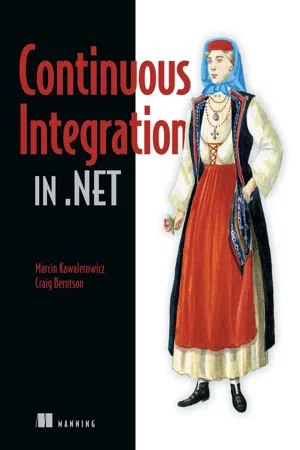
- 328 pages
- English
- ePUB (mobile friendly)
- Available on iOS & Android
Continuous Integration in .NET
About this book
Continuous integration is a software engineering process designed to minimize "integration hell." It's a coordinated development approach that blends the best practices in software delivery. For.NET developers, especially, adopting these new approaches and the tools that support them can require rethinking the development process altogether. Continuous Integration in.NET is a tutorial for developers and team leads that teaches readers how to re-imagine their development strategy by creating a consistent continuous integration process. This book shows how to build on the tools they already know -.NET Framework and Visual Studio - and to use powerful software like MSBuild, Subversion, TFS 2010, Team City, CruiseControl.NET, NUnit, and Selenium. Purchase of the print book comes with an offer of a free PDF, ePub, and Kindle eBook from Manning. Also available is all code from the book.
Frequently asked questions
- Essential is ideal for learners and professionals who enjoy exploring a wide range of subjects. Access the Essential Library with 800,000+ trusted titles and best-sellers across business, personal growth, and the humanities. Includes unlimited reading time and Standard Read Aloud voice.
- Complete: Perfect for advanced learners and researchers needing full, unrestricted access. Unlock 1.4M+ books across hundreds of subjects, including academic and specialized titles. The Complete Plan also includes advanced features like Premium Read Aloud and Research Assistant.
Please note we cannot support devices running on iOS 13 and Android 7 or earlier. Learn more about using the app.
Information
Part 1. Make it happen
Chapter 1. Understanding continuous integration
- Continuous integration theory
- A Hello World CI example
- A preliminary list of CI tools
1.1. What does it mean to integrate continuously?
1.1.1. Defining continuous integration
Continuous Integration is a software development practice where members of a team integrate their work frequently, usually each person integrates at least daily—leading to multiple integrations per day. Each integration is verified by an automated build (including test) to detect integration errors as quickly as possible. Many teams find that this approach leads to significantly reduced integration problems and allows a team to develop cohesive software more rapidly.
CI is the embodiment of tactics that gives us, as software developers, the ability to make changes in our code, knowing that if we break software, we’ll receive immediate feedback ... [It is] the centerpiece of software development, as it ensures the health of software through running a build with every change.Paul Duval, Continuous Integration
(Addison-Wesley, 2007)
An automated process that builds, tests, analyzes, and deploys an application to help ensure that it functions correctly, follows best practices, and is deployable. This process runs with each source-code change and provides immediate feedback to the development team.
Table of contents
- Copyright
- Dedication
- Brief Table of Contents
- Table of Contents
- Preface
- Acknowledgments
- About this Book
- About the Authors
- About the Cover Illustration
- Part 1. Make it happen
- Chapter 1. Understanding continuous integration
- Chapter 2. Setting up a source control system
- Chapter 3. Automating the build process
- Chapter 4. Choosing the right CI server
- Chapter 5. Continuous feedback
- Chapter 6. Unit testing continuously integrated code
- Part 2. Extend it
- Chapter 7. Performing integration, system, and acceptance testing
- Chapter 8. Analyzing the code
- Part 3. Smooth and polish it
- Chapter 9. Generating documentation
- Chapter 10. Deployment and delivery
- Chapter 11. Continuous database integration
- Chapter 12. Extending continuous integration
- Index
- List of Figures
- List of Tables
- List of Listings